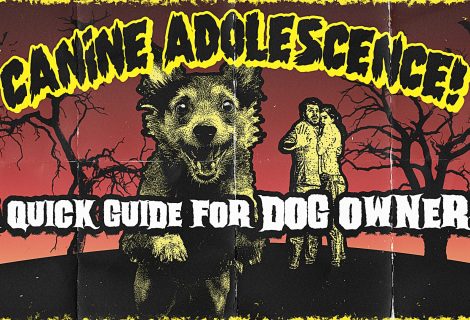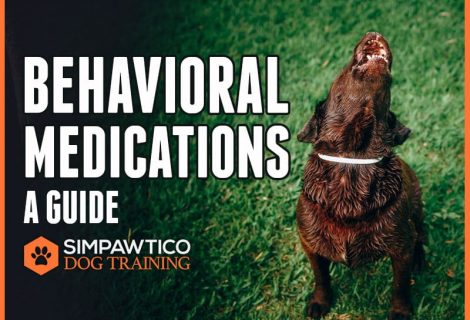Separation Anxiety in Dogs – Tips, Resources, and Help
This post contains affiliate links. These won’t cost you anything, but the commissions we may earn through them help offset the cost of dog treats. Thanks for your support! I have gotten many requests on YouTube, Facebook, and through email asking to do a video on Separation Anxiety in Dogs, So here we go!
Separation Anxiety In Dogs: A Lot To Cover
So right away, I want to say that a one-page post or a 7-10 minute YouTube video are both woefully inadequate to cover everything to do with Separation Anxiety. There are many factors and moving parts to it, and every case is unique. This post+video is not going to give you quick fixes. I will, however, help you better understand the issue and point you in the right direction to find good resources.
Clearing Up The Terms
Let’s start off by clearing up the terminology. The term “Separation Anxiety” has been bandied so much that it’s lost much of its meaning. Everybody thinks that when their dog chews up a shoe while they’re gone, or pees on the rug, looks sad when they leave, or acts silly when they come home, they must have separation anxiety. Generally, this is not the case. In fact, some of these are just simple training issues that haven’t been resolved through practice and consistency. In other cases, it’s more accurate to call it “distress,” and there’s a difference. Also, we need to see if it’s a case of separation or just isolation. There’s a difference there, too.
So, let’s look at these.
Separation problems stem from a dog’s attachment to one person or a group of people. In these instances, no other person or animal can alleviate the stress. The only thing presently that will help is the return of the specific person or persons.
Isolation problems are more about not wanting to be alone. Dogs are extremely social animals. That is to say, they seek company and companionship and form close social groups. In these cases, another person or even another animal can help alleviate the problem.
Each of these types of stressors—separation, and isolation—then exist on a sliding scale, with distress being at the low end and true anxiety being at the high end. True separation or isolation anxiety is serious stuff. Some dogs bloody themselves escaping from crates that jump out of third-story windows and work themselves into frothy states of wide-eyed panic. These are clinical cases that require professional intervention.
Most Of Your Dogs Are Experiencing “Distress”
Distress is what most of you out there are experiencing, not anxiety. Whining or barking when you leave is not anxiety. Chewing up tissues and pillows while you’re gone is not anxiety. At best, they’re symptoms of boredom, and at worst, they’re symptoms of distress which is easily addressed in many cases. So, for example, a dog with mild isolation distress will get itchy about being alone, get bored, and start doing things to occupy himself, like chewing or barking. In these cases, sometimes just giving them things to do that they enjoy will help. Sometimes they need company—another person or even another pet. Here’s where a pet sitter or a dog walker in the middle of the day might help.
First Steps
To start helping your dog, you’ll need to determine whether your dog has a problem with separation or just isolation and then objectively measure how severe things are. Don’t buy into the notion that it’s automatically anxiety or even that it’s automatically separation. Our egos would love us to believe it’s always about us, but realistically it might not be.
Making these distinctions is useful because it changes how you approach the situation. Separation problems are generally harder to fix than isolation problems, depending on how severe things are. We all do a disservice when we start labeling everything “Separation Anxiety” when some dogs out there truly need serious help, and we lump them in with dogs that just need a chew toy and some training. This whole problem gets even more complicated when dogs have pent-up energy throughout the day without reasonable outlets. It also becomes more pronounced when dogs are never taught HOW to be alone.
Gadgets and Gear
Now, there are gadgets and bits of gear out there that are designed to keep your dog busy throughout the day. Things like DAP and relaxing flower essences, Thundershirts, music and tone therapy, interactive toys like the Manners Minder, the Wobbler, and even basic Kong toys. But please understand that these are not the solutions. They’re only part of the solution. And they’re not plug-and-play kinds of things or “set-it-and-forget-it.” You MUST train your dog how to interact with them and train your dog to love them. Yes, even Thundershirts.
As I’ve said many times before: it’s not what it is; it’s what you’ve trained it to be. If you buy something and leave it with them, the chances it will change anything are almost zero. This brings me to an important point: there are no cookie cutters for anxiety or distress. There are no magic bullets. There are no 123 fixes that you find on a Separation Anxiety board on Pinterest that are going to do the job. Think about people you know, maybe yourself, that suffer from anxiety. There isn’t just a thing you buy or a pin you read that fixes it, is there?
So What Can We Do?
Well, for starters, it’s predictable and preventable, like almost every other problem out there. So if you’re watching this and you have a new puppy, or even a newly adopted adolescent dog, teach them how to be alone for periods. A dog needs to be content with spending time alone. If you’ve watched my toy training video or my Kong video, you know that one of the main points is training chew toys to be outlets for exactly the kind of stress being alone creates.
Take a look at your dog’s diet. Do your homework and get the best you can reasonably afford. A crappy diet will most definitely exacerbate anxiety and distress problems, just like it does in humans.
Get your dog some exercise and some mental stimulation. Activities like flyball, triebbal, rally, agility, nosework, and K9 games are ones that not only get the blood moving but help the brain grow. Manage your dog’s space. Use gates to limit access to parts of the house. Crate train them.
These are just the tip of the iceberg.
Recommended Reading
To help you wrap your head around this process, I recommend some really good books on the subject.
- The first one is Separation Anxiety in Dogs: Next Generation Treatment Protocols and Practices by Malena DeMartini-Price. This book represents the latest in a behavioral understanding of the problem and lays the strategies out in a clear, straightforward manner.
- Another good one is I’ll be Home Soon: How to Prevent and Treat Separation Anxiety by Patricia B. McConnell Ph.D. She’s a stalwart figure in the behavior community and her work forms the basis for most of it out there.
- Finally, there is Don’t Leave Me: Step-by-Step Help for your Dog’s Separation Anxiety by Nicole Wilde, CPDT-KA. Nicole is a nationally recognized consultant; her books and articles are always gold. Very easy to read and accessible for everyone.
Pick up one or all three, and see if they can guide you to solve your problem. At the very least, they’ll help you build a foundation to work with while you seek help. And you should seek help. Some anxiety or distress issues stem from genetics, or past experiences, which we have no control over.
Getting Help
My best piece of advice is to hire a Behaviorist. A behaviorist is different than a trainer. Your local dog trainer will usually not have the experience or knowledge to address anything more than some simple distress adequately. A good behaviorist will help you design a plan that fits your dog and lifestyle. A behaviorist will know how to problem solve and offer multiple solutions. These can include plans for:
- management
- nutrition
- exercise
- mental stimulation
- and training
In a robust approach, these will all be supported by adjunctive strategies like drug therapy, desensitization, and conditioning. And your behaviorist will help you train those gadgets and gear we mentioned earlier so they actually WORK for you.
Find a Behaviorist or Consultant
To find a qualified behaviorist or certified behavioral consultant, start with these searches
- The International Association of Animal Behavior Consultants (IAABC). You’ll be looking for a Certified Dog Behavior Consultant (CDBC). Search here.
- The Certification Council of Professional Dog Trainers (CCPDT). You’ll be looking for a Certified Behavior Consultant, Canine, knowledge assessed (CBCC-KA). Search here.
- The American Veterinary Society of Animal Behaviorists (AVSAB). Search here.
- The Association of Animal Behavior Professionals (AABP). Search here.
Membership in one or more professional organizations is a good start. It indicates standards met, communication with colleagues, and a commitment to keeping continuing education.
Look for knowledge in positive reinforcement methods, classical conditioning, progressive desensitization, and making food, toys, and play integral parts of building good behaviors. This is a must. Any kind of aversive techniques that are painful, scary, or stern will be absolutely counterproductive. Now, there are trainers out there with experience with behavior consulting and vice versa. You may find that rare someone who’s versed in both training and behavioral methodology.
Once you find a person, ask about their professional training and their experience—always ask about their experience level. A seasoned practitioner with fewer professional credentials is preferable to someone with many credentials but limited or no experience.
Also, contact the local shelters and rescues for their recommendations. These organizations see a thousand times the number of dogs you’ve ever owned and have a roster of professionals they rely on.
Look for someone who recognizes the importance of YOU working through the problem rather than sending the dog somewhere to get “fixed.”
Anxiety and distress are completely inappropriate for any Board and Train services. Work needs to be done at home.
Where NOT To Look
Please, do not ask your vet for behavior advice UNLESS you are inquiring about drug therapy suggested by a behaviorist. Vets are not trained in behavior. They are trained in anatomy, procedures, diagnosis, treatment, and medicine. They will be the medicinal and drug expert, but your behaviorist will know better what to do in conjunction it. Look: I respect the veterinary community greatly and I always learn tons from them. But I have seen vets prescribe drugs to dogs that didn’t need it, and I’ve seen dogs put through ridiculous exercises when they needed drugs and management.
My vet is a brilliant woman. If the issue is a symptom or a treatment or a procedure, she’s an ace. but she knows when to defer to others which is the mark of a true professional. If someone asks her a question on behavior, she’s the first to refer out. I know it is tempting to ask the pet professionals in your life for help, but seek the best sources. You don’t ask your plumber for electrical advice, right?
Also, do not ask for or take advice from pet store employees. These people are there to tell you what’s on sale. That’s like asking someone who works at Rite Aid to give you medical advice. Always seek advice from the best sources, especially for something like this.
- If you need training advice, call a trainer.
- If your pet is hurt or sick, call your vet.
- If you have a grooming question, call your groomer.
- If your dog’s diet needs tweaking, contact a nutritionist.
- And if you have behavior problems, call a behaviorist.
GOOD LUCK!
Everything I’ve mentioned in this post+video is linked below. Good luck to you if you’re struggling, whether it be easily solved Isolation Distress or you’re in for the long haul with real Separation Anxiety. Don’t be afraid to ask for help, and make sure to explore the resources around you.
As always, keep learning and keep practicing, and we’ll see you next time. Thanks for looking!
RESOURCES
Some Recommended Products
Some of the links below are affiliate links. These won’t cost you anything, but the commissions we may earn through them help offset the cost of dog treats. Thanks for your support!
D.A.P. (Dog Appeasing Pheromones)
Bach Rescue Remedy, Pet (Natural Stress Relief For Pets)
We also recommend monthly boxes to keep novel toys coming in. Take a look at our rundown of which ones are the best.








Trackbacks for this post